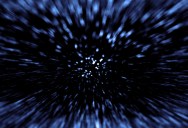A Very Special Particle From The First Millionth Of A Second After The Big Bang Has Been Discovered
We have a lot of pressing concerns for the here and now – the cost of living, global warming, and the current political landscape, to name just a few.
Perhaps that’s why thinking way, way back to a time when things were simple – like, beginning of the universe simple – is so appealing.
Recently, observers at CERN’s Large Hadron Collider (LHC), spotted a bit of data that they thought was super interesting.
When atoms and subatomic particles swirl and crash into each other within the collider they produce a whole bunch of data. Around 90 petabytes of data, which could fill 90,000 1-terabyte hard drives, is saved every year.

Most of that data is stored on giant banks of magnetic tape, and honestly, it’s often too much data to even consider going through.
Recently, though particle physicists have unearthed a gem. It’s a strange particle called X(3872), and those scientists believe it could provide the briefest of glimpses into what the universe looked like in the first millionth of a second after the Big Bang.
Yen-Jie Lee, a particle physicist at MIT, says that they’re not sure what it looks like, because “theoretical predictions from different groups did not agree with each other.”
This particle has been sighted before. The first time was in 2003, when Japanese scientists at the particle accelerator there glimpsed it before it quickly decayed and vanished.
Scientists then wondered whether or not they could find X(3872) in quark-gluon plasma. Quarks are the smaller particles inside of protons and neutrons, and at extremely high temperatures protons and neutrons break apart and dissolve into basically soup.

That’s quark-gluon plasma.
It can be created by smashing atomic nuclei together at very high speeds (heavy-ion collision), which leaves behind data trails that researchers can search through.
Lee says it’s not as easy as all that, though.
“Nobody has tried to detect X(3872) in heavy-ion collisions before it is a very difficult task.”
Jing Wang, a doctorate student at MIT, explains one of the issues.
“In proton-proton collisions, there are about a few tens of particles produced in one event, while in heavy-ion collisions, there are typically several thousand, even 10,000 particles per event.”
Finding X(3872) in there is like looking for a needle in a haystack, but Wang and her colleagues figured that’s the sort of thing computer programs are literally built for – so they trained an algorithm to look for X(3872)’s signature, fingerprints, and decayed particles.
It was successful, telling us that quark-gluon plasma filled the universe in the first millionths of a second of its life – before even matter had formed.
Physicists are thinking that they can use quarks and gluons in the plasma to break the particle apart and see what’s inside.
Like a really small, really abstract Easter egg.
Typical protons and neutrons are made up of three quarks, but some think X(3872) could be comprised of four – a tetraquark. Those need high energies to stay together and are pretty rare.
Other physicists think it’s more likely that X(3872) is built from mesons – made from one quark and one antiquark. Though mesons sometimes appear on earth, we’ve never documented a large particle made up of more than one of them.

In order for answers, scientists will have to wait for more data – more collisions, more quark-gluon plasma, etc etc.
“It is going to be exciting to follow up this line of study with a much larger amount of data.”
Scientists love data.
As for me, it is cool to think more answers about the origins of the universe could soon be revealed.
If you enjoyed that story, check out what happened when a guy gave ChatGPT $100 to make as money as possible, and it turned out exactly how you would expect.

Sign up to get our BEST stories of the week straight to your inbox.




